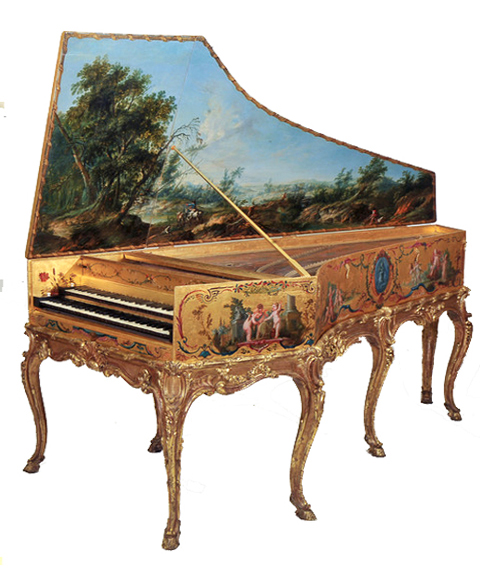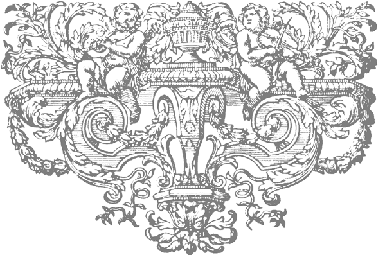Franco-Flemish double-manual harpsichord,
![]()
important features of this harpsichord

The physical size of the instrument is: 2m 36cm long, by 98cm wide, by 98 cm high. The size of the packing case is roughly the same with 15cm added to each dimension.
The instrument has an extremely fine decoration and a stunningly-beautiful stand. The inside of the lid bears a French painting of a sylvan landscape with figures and cattle which must have been painted in 1750 when the case was widened for the first time. This painting has been attributed to Jean-Baptiste Le Prince (1734-1781), who came to work for Francois Boucher in 1750, the same year that the decoration and the primary ravalement of the harpsichord was carried out. The whole of the outside of the instrument is decorated in gold vernis martin. The lockboard, cheek, bentside and tail of the case have putto figures engaged in a 'Triumph of Love'. The outside of the lid has 2 large paintings and an elegant rococo decoration around these.
Even the hinges and hardware are of stunning quality and are hand-chased and fire gilt.
The figure
There also seems a strong likelihood that the
In the period around 1786, the instrument was again widened, but this time on the treble side in order extend it up to f3 and give it a full 5-octave F1 to f3 compass. This alteration was carried out by Jacques Barberini (whose calling card was found glued to the inside surface of the baseboard when the instrument was opened by Roberto de Regina in Buenos Aires in 1970) and by Nicolas Hoffman who added a genouillère and an additional fourth peau de buffle register. The later alteration was signed on the keywell surface of the lower belly rail: '[Re]fait par [N] Hoffman a Paris 1786'. This is written upside down when viewed from inside the keywell probably indicating that it was signed after the lower belly rail was put in place and before the baseboard was placed on the instrument.
The ravalement framing, both of the 1750 bass ravalement and of the later 1786 treble ravalement, is very well designed and carried out and, from a statics point of view, provides an extremely rigid and stable structure to the case. The soundboard is laid out in the classic Flemish way and, as I have pointed out in my articles referred to below, sounds at least as sweet as a genuine Ruckers. The superb musical qualities of the instrument were obviously recognised in eighteenth-century Paris even before it was ravalé, and therefore a great deal of expense and attention was paid to its external decoration in order to match is visual appearance with its sound. So much attention would surely not have been expended on the decoration of this instrument in 1750 unless it were already recognised as a fine and beautiful-sounding instrument. Both of the eighteenth-century ravalements were carried out extremely competently and professionally and respect all of the original Flemish acoustical material without compromising the musical qualities of the instrument in any way. Indeed the ravalement alterations would only have improved the qualities and usefulness of the existing instrument.
Musically the instrument now has the classic eighteenth-century French disposition with two keyboards and a compass of F1 to f3, 5 octaves with 2 strings at 8' pitch and one at 4' pitch, a shove-manual keyboard coupler and four registers including the peau de buffle . The upper-manual 8' choir of strings has a buff stop which dampens the sound of the upper-manual 8' strings using soft leather pads placed just behind the nut.
As such, the instrument is capable of playing almost the entire harpsichord repertoire but is, of course, most suited to the late eighteenth-century French literature. The sound quality is, if anything, better than any instrument I have ever heard including the very best of the instruments by the various members of the Ruckers family that were later mis a ravalement in Paris and of the instruments by such 18th-century makers as Blanchet and Taskin.

As a result of the initial examination of this instrument many years ago now, some conclusions about the origin and the design of this instrument along with a detailed analysis of the instrument have been published by me in two articles:
'An Analysis of the Origins of a Large Franco-Flemish Double-Manual Harpsichord - Would a Ruckers by Any Other Name Sound as Sweet?', The Early Keyboard Journal, XX (2005) 49-80.
